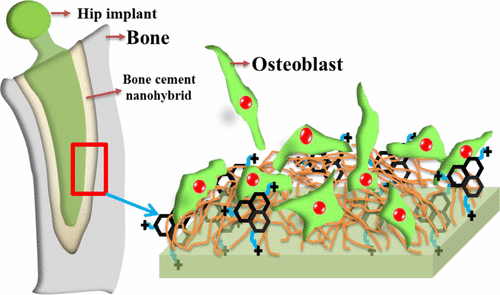当前位置:
X-MOL 学术
›
Bioconjugate Chem.
›
论文详情
Our official English website, www.x-mol.net, welcomes your
feedback! (Note: you will need to create a separate account there.)
Osteoconductive Amine-Functionalized Graphene–Poly(methyl methacrylate) Bone Cement Composite with Controlled Exothermic Polymerization
Bioconjugate Chemistry ( IF 4.0 ) Pub Date : 2017-08-21 00:00:00 , DOI: 10.1021/acs.bioconjchem.7b00241 Rakesh Sharma , Govinda Kapusetti 1 , Sayali Yashwant Bhong 1 , Partha Roy 2 , Santosh Kumar Singh 3 , Shikha Singh 4 , Chelladurai Karthikeyan Balavigneswaran , Kaushal Kumar Mahato , Biswajit Ray 4 , Pralay Maiti , Nira Misra
Bioconjugate Chemistry ( IF 4.0 ) Pub Date : 2017-08-21 00:00:00 , DOI: 10.1021/acs.bioconjchem.7b00241 Rakesh Sharma , Govinda Kapusetti 1 , Sayali Yashwant Bhong 1 , Partha Roy 2 , Santosh Kumar Singh 3 , Shikha Singh 4 , Chelladurai Karthikeyan Balavigneswaran , Kaushal Kumar Mahato , Biswajit Ray 4 , Pralay Maiti , Nira Misra
Affiliation

|
Bone cement has found extensive usage in joint arthroplasty over the last 50 years; still, the development of bone cement with essential properties such as high fatigue resistance, lower exothermic temperature, and bioactivity has been an unsolved problem. In our present work, we have addressed all of the mentioned shortcomings of bone cement by reinforcing it with graphene (GR), graphene oxide (GO), and surface-modified amino graphene (AG) fillers. These nanocomposites have shown hypsochromic shifts, suggesting strong interactions between the filler material and the polymer matrix. AG-based nanohybrids have shown greater osteointegration and lower cytotoxicity compared to other nanohybrids as well as pristine bone cement. They have also reduced oxidative stress on cells, resulting in calcification within 20 days of the implantation of nanohybrids into the rabbits. They have significantly reduced the exothermic curing temperature to body temperature and increased the setting time to facilitate practitioners, suggesting that reaction temperature and settling time can be dynamically controlled by varying the concentration of the filler. Thermal stability and enhanced mechanical properties have been achieved in nanohybrids vis-à-vis pure bone cement. Thus, this newly developed nanocomposite can create natural bonding with bone tissues for improved bioactivity, longer sustainability, and better strength in the prosthesis.
中文翻译:

受控放热聚合的骨导电性胺官能化石墨烯-聚(甲基丙烯酸甲酯)骨水泥复合材料
在过去的50年中,骨水泥在关节置换术中得到了广泛的应用。然而,具有基本特性如高抗疲劳性,较低的放热温度和生物活性的骨水泥的开发仍是尚未解决的问题。在我们目前的工作中,我们通过用石墨烯(GR),氧化石墨烯(GO)和表面改性的氨基石墨烯(AG)填料增强了骨水泥的所有上述缺点。这些纳米复合材料表现出七色变迁,表明填料与聚合物基体之间有很强的相互作用。与其他纳米杂化物和原始骨水泥相比,基于AG的纳米杂化物显示出更高的骨整合度和更低的细胞毒性。它们还降低了细胞的氧化应激,在将纳米杂交体植入兔子后的20天内导致钙化。它们显着降低了放热固化温度至体温的温度,并增加了凝固时间,以方便从业人员,这表明可以通过改变填料的浓度来动态控制反应温度和沉淀时间。相对于纯骨水泥,纳米混杂物已经实现了热稳定性和增强的机械性能。因此,这种新开发的纳米复合材料可以与骨组织建立自然的结合,从而提高生物活性,延长可持续性并在假体中具有更好的强度。这表明可以通过改变填料的浓度来动态地控制反应温度和沉降时间。与纯骨水泥相比,纳米杂化材料已实现了热稳定性和增强的机械性能。因此,这种新开发的纳米复合材料可以与骨组织建立自然的结合,从而提高生物活性,延长可持续性并在假体中具有更好的强度。这表明可以通过改变填料的浓度来动态地控制反应温度和沉降时间。与纯骨水泥相比,纳米杂化材料已实现了热稳定性和增强的机械性能。因此,这种新开发的纳米复合材料可以与骨组织建立自然的结合,从而提高生物活性,延长可持续性并在假体中具有更好的强度。
更新日期:2017-08-21
中文翻译:

受控放热聚合的骨导电性胺官能化石墨烯-聚(甲基丙烯酸甲酯)骨水泥复合材料
在过去的50年中,骨水泥在关节置换术中得到了广泛的应用。然而,具有基本特性如高抗疲劳性,较低的放热温度和生物活性的骨水泥的开发仍是尚未解决的问题。在我们目前的工作中,我们通过用石墨烯(GR),氧化石墨烯(GO)和表面改性的氨基石墨烯(AG)填料增强了骨水泥的所有上述缺点。这些纳米复合材料表现出七色变迁,表明填料与聚合物基体之间有很强的相互作用。与其他纳米杂化物和原始骨水泥相比,基于AG的纳米杂化物显示出更高的骨整合度和更低的细胞毒性。它们还降低了细胞的氧化应激,在将纳米杂交体植入兔子后的20天内导致钙化。它们显着降低了放热固化温度至体温的温度,并增加了凝固时间,以方便从业人员,这表明可以通过改变填料的浓度来动态控制反应温度和沉淀时间。相对于纯骨水泥,纳米混杂物已经实现了热稳定性和增强的机械性能。因此,这种新开发的纳米复合材料可以与骨组织建立自然的结合,从而提高生物活性,延长可持续性并在假体中具有更好的强度。这表明可以通过改变填料的浓度来动态地控制反应温度和沉降时间。与纯骨水泥相比,纳米杂化材料已实现了热稳定性和增强的机械性能。因此,这种新开发的纳米复合材料可以与骨组织建立自然的结合,从而提高生物活性,延长可持续性并在假体中具有更好的强度。这表明可以通过改变填料的浓度来动态地控制反应温度和沉降时间。与纯骨水泥相比,纳米杂化材料已实现了热稳定性和增强的机械性能。因此,这种新开发的纳米复合材料可以与骨组织建立自然的结合,从而提高生物活性,延长可持续性并在假体中具有更好的强度。











































 京公网安备 11010802027423号
京公网安备 11010802027423号